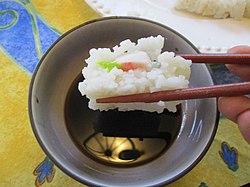 | |
| Alternative names | Dipping sauce |
|---|---|
| Type | Condiment |
A dip or dipping sauce is a common condiment for many types of food. Dips are used to add flavor or texture to a food, such as pita bread, dumplings, crackers, chopped raw vegetables, fruits, seafood, cubed pieces of meat and cheese, potato chips, tortilla chips, falafel, and sometimes even whole sandwiches in the case of jus. Unlike other sauces, instead of applying the sauce to the food, the food is typically placed or dipped into the sauce.
Contents
Dips are commonly used for finger foods, appetisers, and other food types. Thick dips based on sour cream, crème fraîche, milk, yogurt, mayonnaise, soft cheese, or beans are a staple of American hors d'oeuvres and are thicker than spreads, which can be thinned to make dips. [1]
Dips in various forms are eaten all over the world and people have been using sauces for dipping for thousands of years. [2]


